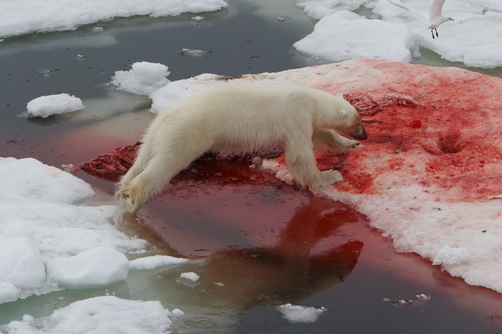The biggest issue with populating your springs is whether the world was always the way it is now, or if at one time things were warmer. If your cold world was once more hospitable and the sort of life now found at the springs was once widespread, then your springs are refugia.
 from http://cba.anu.edu.au/research/highlights/ecological-speciation-role-climatic-refugia
from http://cba.anu.edu.au/research/highlights/ecological-speciation-role-climatic-refugia
Refugia are sanctuary sites where creatures can survive and ride out widepread changes in conditions. One of my favorites are the tiny watering holes in the Sahara desert where Nile crocodiles live - these were stranded here as the world changes and the Sahara dried up. They are little and inbred but they survive.
 from http://journals.plos.org/plosone/article?id=10.1371/journal.pone.0014734
from http://journals.plos.org/plosone/article?id=10.1371/journal.pone.0014734
That opens the most possibilities for a variety of creatures in your warm pools and ponds. Imagine what lived in your world when it was warm, and then roll time forward and imagine how a stranded population of these things would change over time.
If your world has always been cold with warm pools then your pools are more like deep hydrothermal sea vents: islands of life surrounded by inhospitable wastes. 
from microbewiki.kenyon.edu
Some of these have ancient lineages of creatures specific only to that site. It turns out that some creatures that specialize in these sites have the ability to colonize other similar sites at a distance - probably by virtue of a planktonic form that by good luck winds up in the right place. I think the purely endemic evolved on site lineages are mostly slimy little things and microbes. Most of the big creatures at these sites are descendants of more widespread lineages (worms, crabs etc).
Since you already have catfish and crabs and seaweeds in your ponds I think you have by default opted for #1: the world was more hospitable once and now has condensed down to your warm pools refugia. In your mind, populate your world as it once was and then populate your springs with the degenerate descendants of the prior world. Some of these holdovers might have the ability to migrate across the wastes from from pool to pool. I think of polar bears which go from hole to hole in the ice, attacking and eating whales and other animals who are restricted to these holes to breathe.

https://www.natgeocreative.com/comp/04/496/1143099.jpg




